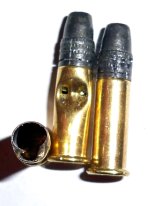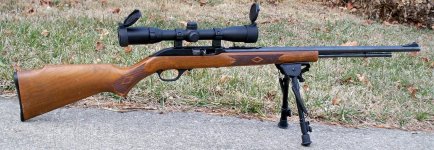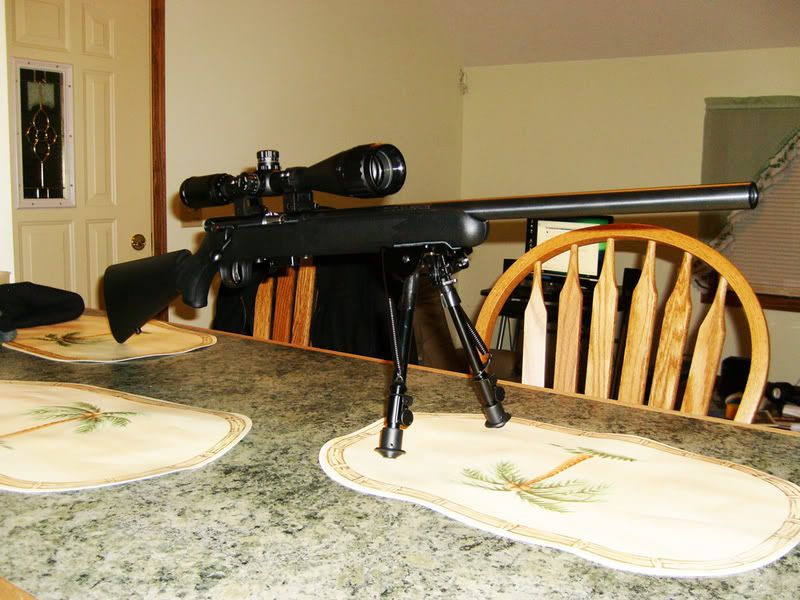Hey guys, new gun owner/shooter/poster.
I had looked and looked for an economic .22 to learn on and I settled on a Marlin Mdl 60 - I was lucky enough to find one at a gun show in Alabama for $75 with some stock damage but I figured for $75 if nothing else I can learn what NOT to do with the next rifle.
I took it home, cleaned it top to bottom, oiled it and put it up for the night. Next day went out and sighted it in. out of about 50 rounds 5 were either misfed or did not eject completely. I shelved it and wrote a few emails to more knowledgeable relatives to no avail.
The mis-ejection is the empty shell not fully escaping the chamber BEFORE the slide closes. The slide catches the shell remains open. Depending on where the shell is caught a misfeed might occur at the same time.
The misfeed is the incoming round does not fully enter the chamber BEFORE the slide closes. This results in the slide scraping the brass shell and gouging the lead leaving a burr and preventing the slide from fully closing (Thankfully). I manually eject the damaged round and chamber the next in line.
I took it out again today and shot another 50 or so. At first it was misfeed/eject on EVERYSHOT! I was getting frustrated. It was about 30 today and the cold didn't help my attitude. I went in and cleaned the feed-fire system (obviously cleared and safetied the rifle first) oiled it up and went back out into the cold. 15 rounds flew through without issue. Reload, misfeed/eject on every 3 shots or so. I put it up again.
My thinking is that the issue has to do with the slide. Possibly the cold is changing the viscosity of the oil and not allowing the slide to move as freely as it should? then I remember the first day it was only 10-15 degrees warmer. Perhaps the recoil spring is worn down?
Any other ideas? When I disassembled it I only broke the rifle down into 4 parts: sock, barrel assembly, slide, and hammer assembly. Beyond that the Marlin manual does not recommend going. I don't have a problem going farther, but I want to know what I am looking for or have a specific reason for going there (I don't want to take it apart just to take it apart).
Any questions or suggestions would be helpful as this is really an annoying and growing cost problem. (Nearly paid double for the ammunition today because of the mid-feeds)
I had looked and looked for an economic .22 to learn on and I settled on a Marlin Mdl 60 - I was lucky enough to find one at a gun show in Alabama for $75 with some stock damage but I figured for $75 if nothing else I can learn what NOT to do with the next rifle.
I took it home, cleaned it top to bottom, oiled it and put it up for the night. Next day went out and sighted it in. out of about 50 rounds 5 were either misfed or did not eject completely. I shelved it and wrote a few emails to more knowledgeable relatives to no avail.
The mis-ejection is the empty shell not fully escaping the chamber BEFORE the slide closes. The slide catches the shell remains open. Depending on where the shell is caught a misfeed might occur at the same time.
The misfeed is the incoming round does not fully enter the chamber BEFORE the slide closes. This results in the slide scraping the brass shell and gouging the lead leaving a burr and preventing the slide from fully closing (Thankfully). I manually eject the damaged round and chamber the next in line.
I took it out again today and shot another 50 or so. At first it was misfeed/eject on EVERYSHOT! I was getting frustrated. It was about 30 today and the cold didn't help my attitude. I went in and cleaned the feed-fire system (obviously cleared and safetied the rifle first) oiled it up and went back out into the cold. 15 rounds flew through without issue. Reload, misfeed/eject on every 3 shots or so. I put it up again.
My thinking is that the issue has to do with the slide. Possibly the cold is changing the viscosity of the oil and not allowing the slide to move as freely as it should? then I remember the first day it was only 10-15 degrees warmer. Perhaps the recoil spring is worn down?
Any other ideas? When I disassembled it I only broke the rifle down into 4 parts: sock, barrel assembly, slide, and hammer assembly. Beyond that the Marlin manual does not recommend going. I don't have a problem going farther, but I want to know what I am looking for or have a specific reason for going there (I don't want to take it apart just to take it apart).
Any questions or suggestions would be helpful as this is really an annoying and growing cost problem. (Nearly paid double for the ammunition today because of the mid-feeds)



